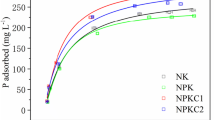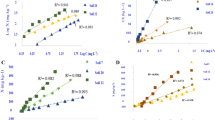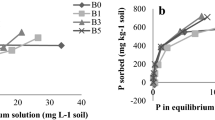Abstract
Crop response to phosphorous (P) application is often erratic in most soil types in the world. In alkaline calcareous soils, P retention and mobilization take place due to precipitation and adsorption. P adsorption isotherms are the powerful tools for assessing optimum P levels for different crops and soils. Laboratory and field studies were carried out to evaluate P sorption capacity in a highly calcareous soil and corresponding fertilizer levels for yielding 0.1 to 1.0 mg P L−1 of soil solution. Although Freundlich adsorption isotherm model showed a better fit than Langmuir model, P fertilizer levels used in the field, ranging from 20 to 150 kg P2O5 ha−1, were based on Langmuir model to yield the estimated P solution. Moreover, nitrogen (N) and potassium (K) were applied at the rates of 120 and 60 kg ha−1 as urea and potassium sulfate (K2SO4), respectively, in a basal treatment at the time of sowing. Grains per spike, 1000-grain weight, grain yield, spike length, and biological yield were increased as the level of P increased, but the non-significant differences among 90, 100, and 120 kg P2O5 ha−1 for most of the above parameters suggested that the former rate could be the maximum level for wheat fertilization in the calcareous soil. Similarly, plant N, P, and K were increased with application of P, but non-significant differences were observed from doses 90 to 120 kg P2O5 ha−1. Moreover, the rate of 90 kg P2O5 ha−1 could yield 0.6 mg P L−1 of soil solution as per Langmuir adsorption isotherm model, while as per Freundlich model, this value could reach only 0.3–0.4 mg P L−1, which is close to the published literature. It is concluded that Freundlich adsorption isotherm is more suitable to be used for the calculation of phosphatic fertilizer rate and its adsorption capacity in the given soil than Langmuir adsorption isotherm.





Similar content being viewed by others
References
Abbaszadeh-Dahaji P, Masalehi F, Akhgar A (2020) Improved growth and nutrition of sorghum (Sorghum bicolor) plants in a low-fertility calcareous soil treated with plant growth-promoting rhizobacteria and Fe-EDTA. J Soil Sci Plant Nutr 20:31–42. https://doi.org/10.1007/s42729-019-00098-9
Adnan M, Shah Z, Fahad S, Arif M, Alam M, Khan IA, Rahman IU (2017) Phosphate-solubilizing bacteria nullify the antagonistic effect of soil calcification on bioavailability of phosphorus in alkaline soils. Sci Rep 7(1):1–13. https://doi.org/10.1038/s41598-017-16537-5
Ali MS, Sutradhar A, Edano ML, Edwards JT, Girma K (2014) Response of winter wheat grain yield and phosphorus uptake to foliar phosphite fertilization. Int J Agron 801626:1–8. https://doi.org/10.1155/2014/801626
Amin A, Nasim W, Mubeen M, Nadeem M, Ali L, Hammad HM, Awais M (2017) Optimizing the phosphorus use in cotton by using CSM-CROPGRO-cotton model for semi-arid climate of Vehari-Punjab, Pakistan. Environ Sci Pollut Res 24(6):5811–5823. https://doi.org/10.1007/s11356-016-8311-8
Ayenew B, Tadesse AM, Kibret K, Melese A (2018) Phosphorous status and adsorption characteristics of acid soils from Cheha and Dinsho districts, southern highlands of Ethiopia. Environ Syst Res 7(1):17. https://doi.org/10.1186/s40068-018-0121-1
Bohn HL, McNeal BL, O’Connor GA (1985) Soil chemistry. Wiley-lnterscience, New York
Chaudhry EH, Ranjha AM, Gill MA, Mehdi SM (2003) Phosphorus requirement of maize in relation to soil characteristics. Int J Agric Biol 5(4):625–629
Delgado A, Madrid A, Kassem S, Andreu L, del Campillo MDC (2002) Phosphorus fertilizer recovery from calcareous soils amended with humic and fulvic acids. Plant Soil 245(2):277–286. https://doi.org/10.1023/A:1020445710584
Dos Reis GS, Thue PS, Cazacliu BG, Lima EC, Sampaio CH, Quattrone M, Dotto GL (2020) Effect of concrete carbonation on phosphate removal through adsorption process and its potential application as fertilizer. J Clean Prod 256:120416. https://doi.org/10.1016/j.jclepro.2020.120416
Eslamian F, Qi Z, Tate MJ, Romaniuk N (2020) Lime application to reduce phosphorus release in different textured intact and small repacked soil columns. J Soil Sediment 20:2053–2066. https://doi.org/10.1007/s11368-020-02564-9
Gee GW, Bauder JW (1986) Particle-size analysis. In: Klute A (ed) Methods of soil analysis. Part 1. Physical and mineralogical methods. Soil Science Society of America, Madison, pp 383–411
Gérard F (2016) Clay minerals, iron/aluminum oxides, and their contribution to phosphate sorption in soils—a myth revisited. Geoderma 262:213–226. https://doi.org/10.1016/j.geoderma.2015.08.036
Hussain A, Ghafoor A, Anwar-Ul-Haq M, Nawaz M (2003) Application of the Langmuir and Freundlich equations for P adsorption phenomenon saline-sodic soils. Int J Agric Boil 5(3):1560–8530
Hussain N, Hyder N, Ahmad N (2004) Influence of phosphorus application on growth and yield components of wheat cultivar Punjab-96. Indus J Plant Sci 3:276–279
Hussain A, Murtaza G, Ghafoor A (2007) Determining internal and external P requirement of wheat on calcareous soils by adsorption isotherms. Pak J Agric Sci 44:103–109
Jahan M, Amiri MB (2018) Optimizing application rate of nitrogen, phosphorus and cattle manure in wheat production: an approach to determine optimum scenario using response-surface methodology. J Soil Sci Plant Nutr 18(1):13–26. https://doi.org/10.4067/S0718-95162018005000102
Jamal A, Fawad M (2019) Effectiveness of phosphorous fertilizers in wheat crop production in Pakistan. J Hortic Plant Res 5:25–29. https://doi.org/10.18052/www.scipress.com/JHPR.5.25
Khan A, Lu G, Zhang H, Wang R, Lv F, Xu J, Zhang S (2019) Land use changes impact distribution of phosphorus in deep soil profile. J Soil Sci Plant Nutr 19(3):565–573. https://doi.org/10.1007/s42729-019-00055-6
Kumari K, Prasad J, Solanki IS, Chaudhary R (2018) Long-term effect of crop residues incorporation on yield and soil physical properties under rice-wheat cropping system in calcareous soil. J Soil Sci Plant Nutr 18(1):27–40. https://doi.org/10.4067/S0718-95162018005000103
Lai DYF, Lam KC (2009) Phosphorus sorption by sediments in a subtropical constructed wetland receiving stormwater runoff. EcolEng 35(5):735–743. https://doi.org/10.1016/j.ecoleng.2008.11.009
Lin C, Busscher WJ, Douglas LA (1983) Multifactor kinetics of phosphate reactions with minerals in acidic soils: I. Modeling and simulation. Soil Sci Soc Am J 47(6):1097–1103. https://doi.org/10.2136/sssaj1983.03615995004700060008x
Manzoor A (2013) Critical soil solution phosphorus concentration essential for plant growth in calcareous soil series. PhD Thesis, SES Department, the University of Agriculture Peshawar, Pakistan
Mehdi SM, Obaid-ur-rehman AMR, Sarfraz M (2007) Adsorption capacities and availability of phosphorus in soil solution for rice wheat cropping system. World Appl Sci J 2(4):244–265
Mihoub A, Bouhoun MD, Saker ML (2016) Phosphorus adsorption isotherm: a key aspect for effective use and environmentally friendly management of phosphorus fertilizers in calcareous soils. Commun Soil Sci Plant Anal 47(16):1920–1929. https://doi.org/10.1080/00103624.2016.1206923
Mihoub A, Bouhoun MD, Naeem A, Saker ML (2017) Low-molecular weight organic acids improve plant availability of phosphorus in different textured calcareous soils. Arch Agron Soil Sci 63(7):1023–1034. https://doi.org/10.1080/03650340.2016.1249477
Mihoub A, Amin AEEAZ, Naeem ASIF, Bouhoun MD (2019) Improvement in phosphorus nutrition of wheat plants grown in a calcareous sandy soil by incorporating chemical phosphorus fertilizer with some selected organic substances. Acta Agric Slov 113(2):263–272. https://doi.org/10.14720/aas.2019.113.2.7
Morel C (2002) Caracterisation de la phytodisponiblite du P du sol par la modelisation du transfert des ions phosphate entre le sol et la solution. Habilitation aDiriger des Recherches. Institut National Polytechnique de Lorraine. Available at: http://www.bordeaux.inra.fr/tcem/rubrique:Actualites[2004]. Accessed 04 Aug 2020
Naeem A, Akhtar M, Ahmad W (2013) Optimizing available phosphorus in calcareous soils fertilized with diammonium phosphate and phosphoric acid using Freundlich adsorption isotherm. Sci World J 2013:1–5. https://doi.org/10.1155/2013/680257
Naseer M, Muhammad D (2014) Direct and residual effect of Hazara rock phosphate (HRP) on wheat and succeeding maize in alkaline calcareous soils. Pak J Bot 46(5):1755–1761
Nelson DW, Sommers LE (1982) Total carbon, organic carbon, and organic matter. In: Page AL (ed) Methods of soil analysis. Part 2. Chemical and microbiological properties, pp 539–579. https://doi.org/10.2134/agronmonogr9.2.2ed.c29
Palanivell P, Ahmed OH, Latifah O, Majid NMA (2020) Adsorption and desorption of nitrogen, phosphorus, potassium, and soil buffering capacity following application of chicken litter biochar to an acid soil. Appl Sci 10:295. https://doi.org/10.3390/app10010295
Penn CJ, Camberato JJ (2019) A critical review on soil chemical processes that control how soil pH affects phosphorus availability to plants. Agriculture 9(6):120. https://doi.org/10.3390/agriculture9060120
Poulsen KH, Nagy R, Gao LL, Smith SE, Bucher M, Smith FA, Jakobsen I (2005) Physiological and molecular evidence for Pi uptake via the symbiotic pathway in a reduced mycorrhizal colonization mutant in tomato associated with a compatible fungus. New Phytol 168(2):445–454. https://doi.org/10.1111/j.1469-8137.2005.01523.x
Rehman OU (2004) Plant availability of native, residual and fertilizer phosphorus in alluvial soils of rice tract. PhD. Dissertation. Dept. Soil Sci., Univ. Agric., Faisalabad, Pakistan
Rehman RA, Qayyum MF (2020) Co-composts of sewage sludge, farm manure and rock phosphate can substitute phosphorus fertilizers in rice-wheat cropping system. J Environ Manage 259:109700. https://doi.org/10.1016/j.jenvman.2019.109700
Richards LA (1954) Diagnosis and improvement of saline and alkali soils. Agriculture handbook 60, Soil and Water Conservative Research Branch, Agricultural Research Service, US Department of Agriculture
Samadi A (2003) Predicting phosphate fertilizer requirement using sorption isotherms in selected calcareous soils of Western Azarbaijan province. Iran Commun Soil Sci Plant Anal 34:2885–2899. https://doi.org/10.1081/CSS-120025213
Seth A, Sarkar D, Masto RE, Batabyal K, Saha S, Murmu S, Mandal B (2018) Critical limits of Mehlich 3 extractable phosphorous, potassium, sulfur, boron and zinc in soils for nutrition of rice (Oryza sativa L.). J Soil Sci Plant Nutr 18(2):512–523. https://doi.org/10.4067/S0718-95162018005001601
Shaheen A (2016) Characterization of eroded lands of Pothwar plateau, Punjab, Pakistan. Sarhad J Agric 32(3):192–201. https://doi.org/10.17582/journal.sja/2016.32.3.192.201
Sharma U, Paliyal SS, Sharma SP, Sharma GD (2014) Effects of continuous use of chemical fertilizers and manure on soil fertility and productivity of maize–wheat under rainfed conditions of the Western Himalayas. Commun Soil Sci Plant Anal 45(20):2647–2659. https://doi.org/10.1080/00103624.2014.941854
Soil Survey of Pakistan (2007) Land resources inventory and agricultural land use plan of Charsadda District. Nat Agric Land Use Plan, Lahore
Steel RGD, Torrie J (1981) Principles and procedures of statistics. A biometric approach, 2nd edn. Mc Graw Hill International Book Co., Singapore City
Von Wandruszka R (2006) Phosphorus retention in calcareous soils and the effect of organic matter on its mobility. Geochem Trans 7:6. https://doi.org/10.1186/1467-4866-7-6
Wang L, Liang T (2014) Effects of exogenous rare earth elements on phosphorus adsorption and desorption in different types of soils. Chemosphere 103:148–155. https://doi.org/10.1016/j.chemosphere.2013.11.050
Yang X, Chen X, Yang X (2019) Effect of organic matter on phosphorus adsorption and desorption in a black soil from Northeast China. Soil Tillage Res 187:85–91. https://doi.org/10.1016/j.still.2018.11.016
Zhou M, Li Y (2001) Phosphorus-sorption characteristics of calcareous soils and limestone from the southern everglades and adjacent farmlands. Soil Sci Soc Am J 65:1404–1412. https://doi.org/10.2136/sssaj2001.6551404x
Zhu Q, Ozores-Hampton M, Li Y, Morgan K, Liu G, Mylavarapu RS (2017) Effect of phosphorus rates on growth, yield, and postharvest quality of tomato in a calcareous soil. Hortic Sci 52(10):1406–1412. https://doi.org/10.21273/HORTSCI12192-17
Acknowledgments
This article is based on the MS thesis research of Aftab Jamal. We are thankful to the laboratory staff of Department of Soil and Environmental Sciences, Faculty of Crop Production Sciences, The University of Agriculture, Peshawar, Pakistan, for assistance in executing the laboratory and field experiment. Special thanks are due for analyzing soil and plant samples.
Author information
Authors and Affiliations
Corresponding authors
Ethics declarations
Conflict of Interest
The authors declare that they have no conflicts of interest.
Additional information
Publisher’s note
Springer Nature remains neutral with regard to jurisdictional claims in published maps and institutional affiliations.
Rights and permissions
About this article
Cite this article
Saeed, M.F., Jamal, A., Muhammad, D. et al. Optimizing Phosphorus Levels in Wheat Grown in a Calcareous Soil with the Use of Adsorption Isotherm Models. J Soil Sci Plant Nutr 21, 81–94 (2021). https://doi.org/10.1007/s42729-020-00344-5
Received:
Accepted:
Published:
Issue Date:
DOI: https://doi.org/10.1007/s42729-020-00344-5




